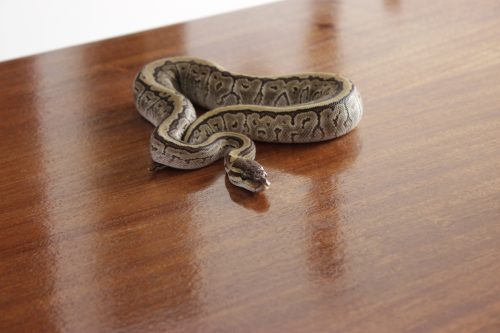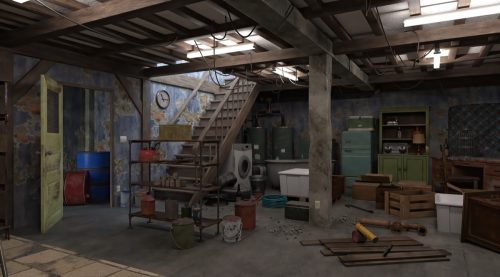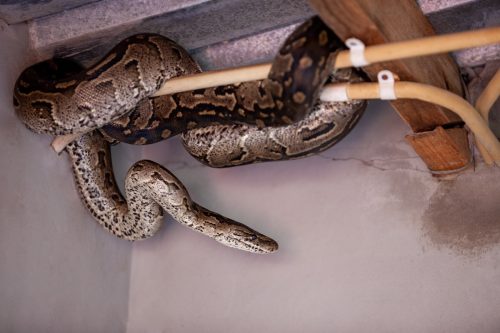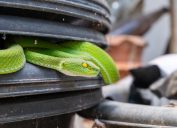The First Place You Should Check for a Snake in Your Home, Experts Say
These creatures can hide all over, but there's one part of the house snakes love the most.

Outside from the precious few who keep them as pets, no one wants a snake in their house. Unfortunately that's an inevitability for many people across the U.S. Some of the most common snakes in the country are also venomous, including rattlesnakes, copperheads, cottonmouths, and coral snakes, but there are plenty more benign varieties that still aren't pleasant to stumble across. And while you may be more likely to find snakes in the wild, these creatures can and will slither their way into your home. If you want to be sure your home is snake-free, experts say there is one important spot to check. Read on to discover the first place you should look for a snake in your house.
READ THIS NEXT: The No. 1 Place Snakes Love to Hide Before They Strike.
There are several key signs of a snake in your house.

Snakes will venture into people's homes for a number of reasons, according to Marty Ford, a home expert and president of BulletpRoof Roof Systems Ltd. They may be searching for "cool and dark places, potential food sources, and a safe spot away from predators." But while snakes might come into your home to hide, there will likely be some key signs present to indicate an infestation.
"Many snakes, both poisonous and non-poisonous, shed their skin in order to grow larger—so there is a good possibility there is a snake nearby if you notice molting in your home," says Laurice Constantine, a home expert and founder of the online home marketplace Casadar. "Snakes may also be present if unexpected noises are emanating from flooring regions."
There's one spot you should check first.

Seeing any signs of a snake means you'll want to act quickly. Melody Estes, a landscape design gardening supervisor from Maine and a consultant at The Project Girl, says the first place you should check for a snake in your house is the basement. "Snakes like dark, humid spaces with lots of hiding places, so the basement makes for a great home for them," she explains.
Jeremy Yamaguchi, a pest expert and CEO of Lawn Love, agrees that you should look in the basement first, noting that other factors could be inviting snakes into that space. According to Yamaguchi, basements are an attractive environment for spiders, frogs, lizards, and mice—all of which are things that snakes eat.
"If you have any of those, you'll very likely see snakes beginning to move in," he warns. "Another factor is that some people feed pets in the basement, or have a living space down there where old food is left out. Both these can attract pests, especially mice, and snakes are soon to follow."
For more home advice delivered straight to your inbox, sign up for our daily newsletter.
There are other areas you should check if you don't have a basement.

Not all homes have a basement area, but snakes don't limit themselves to subterranean spaces. "If you don't have a basement, then your bedroom, under your bed, in your closet, or in the bathroom are other places snakes love to hide," Estes says.
Roger Dickens, a wildlife technical services manager with Ehrlich Pest Control, also recommends checking attics and crawl spaces. "They are areas with minimal disturbance and offer prey species opportunities and shelter or protection from other predatory species," he notes.
According to Dickens, garages "tend to be a popular hiding spot" for snakes as well. "Most of the time, it's due to the stored items inside the garage not being moved regularly," he says.
You should call a professional if you do find a snake.

Lisa Dietrich, a home expert and founder of Remote Canteen, says there are several steps you should take when searching for snakes in your home—especially the basement. "Snakes often enter homes through foundation cracks or openings around pipes and vents," Dietrich explains. "Start by doing a thorough inspection of the foundation and any cracks or openings. Then, check around any pipes or vents, and look behind any boxes or storage containers. If you still don't see any snakes, try turning on a light and checking under furniture and appliances."
But what happens if you do find a snake? According to Dickens, you should never try removing the snake yourself. "This is a dangerous and potentially life-threatening task and should be handled by professionals," he warns. Instead, he says you should call a pest management professional that has experience with wildlife management to get the snake out of your house.
Even if you only suspect a snake is your home, calling a specialist can really help. "The professional can identify any conducive conditions that are attractive to snakes and their prey species," Dickens adds. "The professional can also develop a control program for the home to prevent snakes in the future."





















